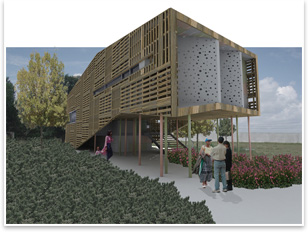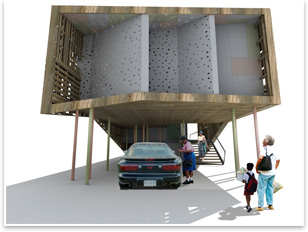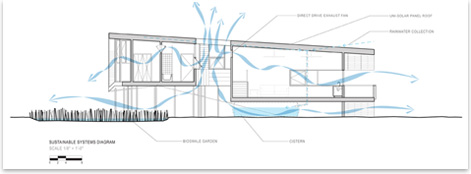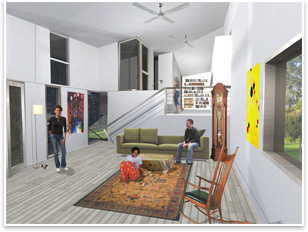| Make It Right Project Brings Affordable, Sustainable Design to New Orleans’ Ninth Ward
by Tracy Ostroff
Associate Editor
 Summary: Brad Pitt—a name you don’t usually see in these pages—receives kudos here for the work he is doing to get the beleaguered residents of New Orleans’ Lower Ninth Ward back in safe, sustainable, and affordable homes. To make this triumvirate of design a reality, he has gathered some of the most highly regarded architects in the world to help the city and her residents recover from the still-evident devastation of Hurricane Katrina. Summary: Brad Pitt—a name you don’t usually see in these pages—receives kudos here for the work he is doing to get the beleaguered residents of New Orleans’ Lower Ninth Ward back in safe, sustainable, and affordable homes. To make this triumvirate of design a reality, he has gathered some of the most highly regarded architects in the world to help the city and her residents recover from the still-evident devastation of Hurricane Katrina.
As part of his Make It Right campaign, Pitt asked 14 architects each to capture the spirit and culture of the area and create designs for a 150-home community over the next two years. This effort will address the dire need for single-family housing in the Lower 9th Ward and act as a catalyst for further rebuilding efforts. The architects selected by the Make It Right team include Adjaye Associates; Billes Architecture; BNIM Architects; Concordia Constructs LLC; Eskew+Dumez+Ripple; Graft; KieranTimberlake Associates; Morphosis; MVRDV; Pugh + Scarpa Architecture; Shigeru Ban Architects; and Trahan Architects. John C. Williams Architects LLC serves as the project’s executive architect.
 The designers are executing the Make It Right vision with plans as impressive as the firms themselves. They were charged with merging the vernacular of pre-Katrina architecture with solutions that reflect today’s sustainable and healthy building practices. The MIR team gave the architects a typology study that included traditional New Orleans housing types such as the Shotgun, the Camelback, and the Creole Cottage, along with current ideas and recommendations for the target area in the Lower Ninth Ward. The MIR team produced a set of guidelines for the houses that set metrics for the final design to ensure that the specific goals of the MIR organizations were met. The team is also using Cradle-to-Cradle thinking to guide materials selection for the new homes. The designers are executing the Make It Right vision with plans as impressive as the firms themselves. They were charged with merging the vernacular of pre-Katrina architecture with solutions that reflect today’s sustainable and healthy building practices. The MIR team gave the architects a typology study that included traditional New Orleans housing types such as the Shotgun, the Camelback, and the Creole Cottage, along with current ideas and recommendations for the target area in the Lower Ninth Ward. The MIR team produced a set of guidelines for the houses that set metrics for the final design to ensure that the specific goals of the MIR organizations were met. The team is also using Cradle-to-Cradle thinking to guide materials selection for the new homes.
Architecture brain trust
After meeting with residents displaced by the devastating storms, Pitt, now a part-time New Orleans resident, began by working with Global Green to sponsor an architecture competition aimed at generating ideas about how to rebuild sustainably. Pitt worked with local community leaders as well as experts from around the world to develop viable ideas for the Lower Ninth Ward. These efforts inspired the Make It Right program.
 Pitt announced the program at the Clinton Global Initiative in September. He is donating $5 million to the effort, as is philanthropist Steven Bing. Pitt told the New York Times that instead of lamenting the lack of progress in New Orleans, he would put the spotlight and his resources on the challenges facing the redevelopment of the Ninth Ward. He teamed with William McDonough + Partners; the architecture firm Graft; and Cherokee, an investment firm based in Raleigh, N.C., that specializes in sustainable redevelopment. Pitt announced the program at the Clinton Global Initiative in September. He is donating $5 million to the effort, as is philanthropist Steven Bing. Pitt told the New York Times that instead of lamenting the lack of progress in New Orleans, he would put the spotlight and his resources on the challenges facing the redevelopment of the Ninth Ward. He teamed with William McDonough + Partners; the architecture firm Graft; and Cherokee, an investment firm based in Raleigh, N.C., that specializes in sustainable redevelopment.
Larry Scarpa, AIA, is one of the architects Pitt tapped for the project and, like the others, is donating his services pro bono. Scarpa, a principal of Pugh + Scarpa Architecture, Santa Monica, Calif., says that although the architects met as a group and had discussions together, all the designs are unique, bringing world-class talent to an area that is languishing as other communities are again reconstituted in Katrina’s wake.
“The area had suffered from a real lack of innovation, so it was almost like a new case study, not unlike those in California in the 1940s and 1950s,” Scarpa says. “It’s a whole different attitude. People are not used to getting good design that is also affordable.” Scarpa’s portfolio brims with such projects, but he noted that for some of the designers, the nexus of sustainability and affordability was a newer endeavor.

Architects’ plans
All the architects are profiled on the Make It Right Web site, along
with detailed renderings of their designs and the philosophies
behind their schemes. Pugh + Scarpa’s proposal refers to
American patchwork quilting traditions, especially those embodied
by the Gee’s Bend abstract geometric style. The architects
employ recycled wooden pallets as a “patchworked” shade
screen wrapping the building, as an alternative to expensive façade
materials. The pallets allow light to fill the space and add texture
and individuality to the exterior. Homeowners will be able to select
from a palette of different pallet colors. The architects are working
with local manufacturers to ensure the viability of this cost-effective
and sustainable off-the-shelf product, which is easily obtainable
and readily replaceable (a tenet of the Make It Right philosophy).
The pallet wrapping is joined by decoratively perforated cement
board on the east and west facades, providing both shade and privacy
while allowing views out and dappled, indirect daylight. At the
same time, convection and the breeze continually move the air.
All the exterior elements will combine and interweave, emerging
as a distinctive pattern-making aesthetic.
The MIR home breaks the prescriptive mold of the traditional home by creating public and private “zones” in which private space is de-emphasized in favor of large public living areas. The organization of the space is intended to transform the way people live—away from a reclusive, isolating layout toward a family-oriented, interactive space. The design is conscious of accommodating an extended family in a small space.
 Scarpa, who, like the other architects, heard from the community members in planning meetings last year, says he heard often about the idea of survivability and organized his home so that a resident would have the ability to escape off the roof of the home. The front porch and the living space are raised five and eight feet off the ground, respectively. Scarpa, who, like the other architects, heard from the community members in planning meetings last year, says he heard often about the idea of survivability and organized his home so that a resident would have the ability to escape off the roof of the home. The front porch and the living space are raised five and eight feet off the ground, respectively.
“Every design addresses basic needs,” Scarpa says. He notes that Pitt says he is committed to building at least one of every type. Residents will have the opportunity to select which home they will build on their lot. “It was pretty easy for us,” Scarpa says of sustainable measures such as materials selection, storm-water retention, and passive and efficient energy approaches.
Now it’s up to the area residents to embrace these tenets in their new homes.
|






